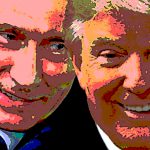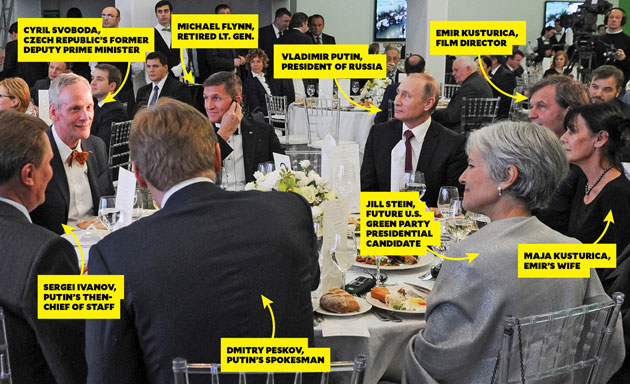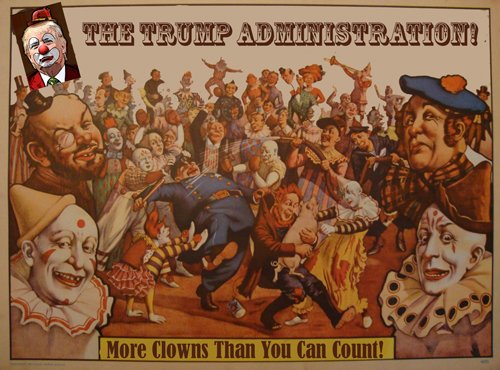Let this soak in: Politico reported last week that the debt Jared and Ivanka were carrying on one Visa card dropped from a range of $100,001 to $250,000 down to a range of $50,001 to $100,000. “However, in revisions to the form before it was formally certified by the Office of Government Ethics on Dec. 26, the outstanding debt for the three credit lines was raised to the higher level.”
That’s credit card debt, people. Average interest rates on credit cards is about 15 percent right now, and of course plebians like us pay a lot more, like 20-something percent. People who run up credit card debt like that have financial issues, somehow. Maybe what they call a “cash flow” problem.
This week, we learned that “Jared and Ivanka have gone from cumulative debt of somewhere between $19 million and $98 million to a range of $31 million to $155 million in the last year alone.” And here I would have been telling them they’d better be saving their money, because once the Trump Administration finally goes down their earning opportunities are going to go down with it.
We learned this week that along with his much amended security clearance forms, Jared recently has been correcting his financial disclosure forms.
Jared Kushner quietly filed an addendum to his personal financial disclosure adding even more previously undisclosed business interests in recent weeks — and may have even more to disclose, according to real estate documents shared with TPM.
Kushner, President Trump’s son-in-law and a top adviser, wrote a letter to White House Deputy Counsel Stefan Passantino dated Jan. 3, 2018 adding a number of additional business interests that had not previously been on his personal financial disclosure form.
That letter, which has not been previously reported, corrects and adds new corporate positions and details of his companies’ structures that he legally was required to disclose, in a seeming attempt to square his filing with spouse Ivanka Trump’s as well as clean up some previously overlooked items.
Also, too:
According to a separate recent update from Ivanka Trump, Kushner appears to have taken out millions more in loans in recent months, a sign that his business may be on the rocks. The couple are currently battling a lawsuit filed in December that accuses them of illegally omitting information for 32 other companies, raising the possibility of hidden conflicts of interest.
Somehow, all those “business interests” must not be generating what we call “income.”
Now, let’s talk about Jared’s lack of a security clearance. Jennifer Rubin wrote,
Kushner met with Sergey Kislyak, the Russian ambassador, to discuss a secret back channel and with the head of a sanctioned Russian bank, VneshEconomBank (VEB). (“The conversation is curious not only because it represents a top Trump official secretly meeting with an arm of the Russian government, but also because accounts of the meeting differ in important ways,” The Atlantic’s David Graham noted at the time. “Kushner says he attended the meeting in his capacity as an adviser to President-elect Trump. But VEB says that the meeting concerned Kushner’s family real-estate business.”) And he was present at the now-infamous June 2016 meeting at Trump Tower attended by a Kremlin-connected lawyer.
Kushner’s financial problems make these contacts all the more troubling. As he was racking up debt, Fordham Law School professor Jed Shugerman tells me, Kushner “also just coincidentally was setting up secret lines to the Kremlin and was meeting with (Russian President Vladmir) Putin’s banker a month after the election. And he just coincidentally was meeting with Russians offering dirt in Trump Tower during the election.” He explains, “Kushner’s massive debts are an important piece of the entire Russia conspiracy on some of the parties’ motives (Kushner, former national security adviser Michael Flynn and Trump) for such inexplicable behavior and such risk-taking.”
And here is what we call the very obvious “bottom line.”
In sum, Kushner has huge and growing debt, many suspicious Russian contacts and a close relationship (perhaps second only to Ivanka’s) with Trump. “The more money Kushner owes, especially to lenders or guarantors who do not have America’s best interests at heart, the more he and his father-in-law the president are subject to compromising pressures at best and outright blackmail at worst,” constitutional lawyer Larry Tribe tells me. “The fact that Kushner, without full security clearance, is permitted to peruse the president’s daily briefing, containing the most secret information that exists, makes all of Kushner’s financial obligations and debts urgent threats to our national security. This situation is unconscionable.”
Does anyone seriously think that Trump and the Kushners are above compromising American interests to make some money on the side? Of course they aren’t.
See also “Jared Kushner May Soon Be Working at TGI Fridays — If They’ll Have Him.”
When Jared Kushner and Ivanka Trump accepted jobs as senior advisers to the president (a.k.a. “Dadâ€), they allegedly saw the gigs as stepping stones that would one day lead to a scenario in which one of them was president. But if the events of the past week (not to mention the past 15 months!) are any indication, political ascendance is not exactly in the cards for these two. Ivanka, of course, has her #WomenWhoWork hashtag to fall back on. Jared’s prospects, sadly, look less bright. His safety net—Kushner Cos.’s real-estate empire—is rapidly filling with holes, thanks in part to his own industry know-how, which could be charitably described as somewhat lacking.
Remember, neither Jared nor Ivanka have ever actually held jobs.
Speaking of security clearance — let’s look up the food chain a bit to Trump himself. Jonathan Chait writes that there’s a real possibility Trump is being blackmailed by Russia now.
Ronan Farrow’s new story shows that Trump habitually pays for sex. He had an affair with former Playboy Playmate Karen McDougal, and offered her money after sex, which she turned down. At another point in the story, he offered adult entertainer Jessica Drake $10,000 for “her company.â€
Farrow’s reporting also implies, without quite establishing as an absolute certainty, that Trump maintained a system for silencing his sexual partners. A network of sleazy operators, sometimes working in conjunction with National Enquirer publisher David Pecker, Trump’s close friend, would pay off women to prevent their stories from seeing the light of day. In any case, previous reporting by The Wall Street Journal has already established that Trump’s personal lawyer, Michael Cohen, paid at least one of his former mistresses to stay quiet.
So, we know Trump habitually pays for sex, and we also know he is willing to pay to keep embarrassing secrets from going public. That is to say, these secrets could be leveraged against him.
This renders the sleazier allegations from the Steele Dossier a lot more credible, Chait writes. Of course, even if they aren’t true, there’s a huge possibility that Trump has financial secrets Putin knows about and America doesn’t.
But I bet Bob Mueller will sniff them out, if he hasn’t already …
But certainly the Russian blackmail theory explains why Trump steadfastly refuses to do anything about Russia. See “Trump’s Conspicuous Silence Leaves a Struggle Against Russia Without a Leader.”
See also “Mueller levels new claim of bank fraud against Manafort.”


 While we were mourning the deaths in Florida, the Bob Mueller investigation has continued. So far we don’t know if anything the Russians did had any effect, and there’s no new word about hacking. But there’s no question the Russians were doing something. Here is some
While we were mourning the deaths in Florida, the Bob Mueller investigation has continued. So far we don’t know if anything the Russians did had any effect, and there’s no new word about hacking. But there’s no question the Russians were doing something. Here is some 

